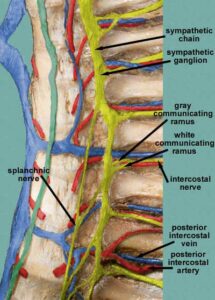9/22 Practice Circle: Listening to the Felt Sense

I’m going with my gut on this. It’s what’s in my heart. I have a funny feeling inside. These common phrases indicate that we recognize that physical sensations in the body have important things to tell us, things that may be beyond the grasp of our conscious awareness.
Several of the world’s wisdom traditions put this insight into concrete terms. Ancient Indians located seven nodes in the body that they referred to as chakras. The Chinese energy medicine tradition identified energy centers called dandiens that correspond closely to the locations of several chakras. By bringing awareness to these energy centers, these wisdom traditions believe it’s possible to restore balance to the body’s systems and invigorate the body and mind.
The locations of these energy centers correspond to places in the body where masses of ganglia leave the spinal cord, known as a neural plexus. These regions are dense with neurons that contain receptors for the same neurotransmitter molecules found in the brain. One theory is that these masses of neurons are processing information at the neurotransmitter level before that information gets to the spinal cord and brain, so that what we ultimately perceive as our conscious reality has already been filtered by the nerve cells in places like our gut, chest and throat. This suggests that our intuition that meaning arises from the body is a sound one. It also suggests that the meaning the body shares with us starts out, not only as pre-verbal, but even pre-conscious functioning on the biochemical level. And because neurotransmitters change the way our neurons are switched on and off, this theory also explains why memories can be stored in the body itself on a pre-conscious level.
A modern way of accessing this inchoate bodily wisdom was developed by the University of Chicago psychologist and philosopher Eugene Gendlin. Gendlin’s Focusing technique is a way of paying careful attention to sensations in the core of the body and engaging them with the verbal mind to gain insights into the meaning behind what he called the “felt sense.”
Gendlin used this example to illustrate the felt sense. You are trying to remember someone’s name; it’s just on the tip of your tongue, so to speak, but you can’t quite think of it. You go through a list of possible names – finally you think of the right one. How do you know it’s right? When you go through the wrong names, you have a vague feeling of incompletion. Suddenly you get to the right name, and you feel an “Ah ha!” moment of release and lightness. How do you know the name is right? Somehow, it feels right.
By intentionally working with the felt sense, bringing awareness to it and allowing it to unfold, Gendlin said that we would be able to access the information that these vague but meaningful sensations contain to better understand our emotions and even move past blockages in our emotional development. That Focusing calls on us to pay attention to sensations in the same core region of the body as the Indian and Chinese energy medicine traditions is intriguing indeed.
When the SBA Practice Circle meets this Sunday, September 22, at 8 pm Central, we’ll share a practice to help us listen to the felt sense. Practice Circle is the SBA’s online meditation and discussion community. We meet via video conference on the second and fourth Sundays of each month. Practice Circle is free to attend, and everyone is welcome. Just click this link on Sunday evening to attend.
